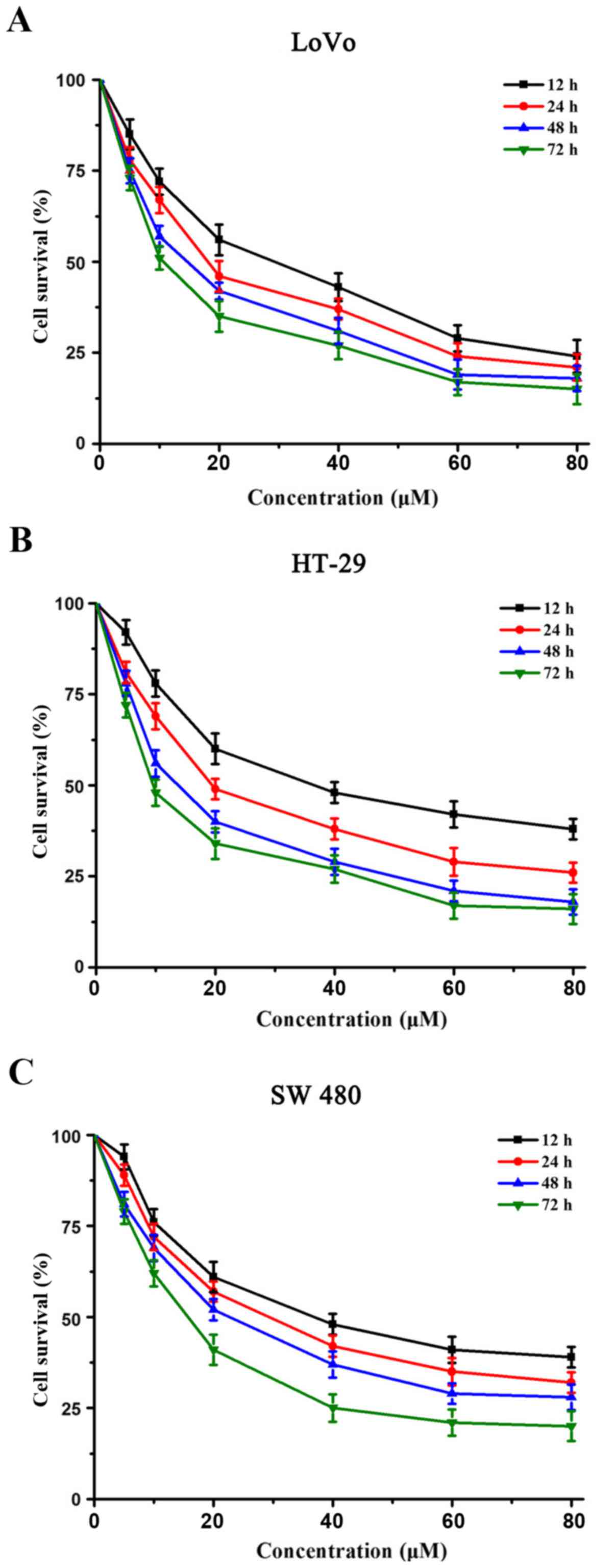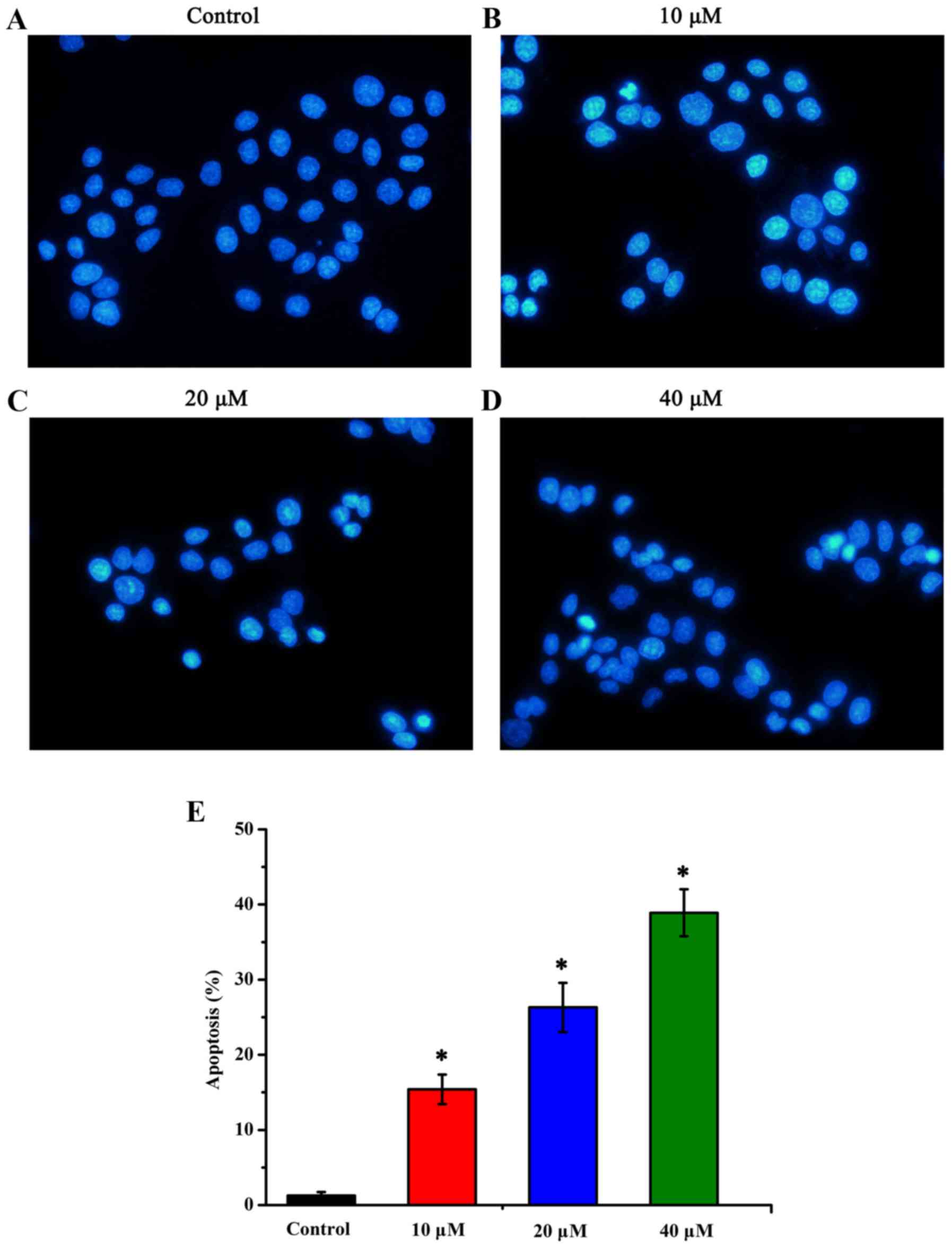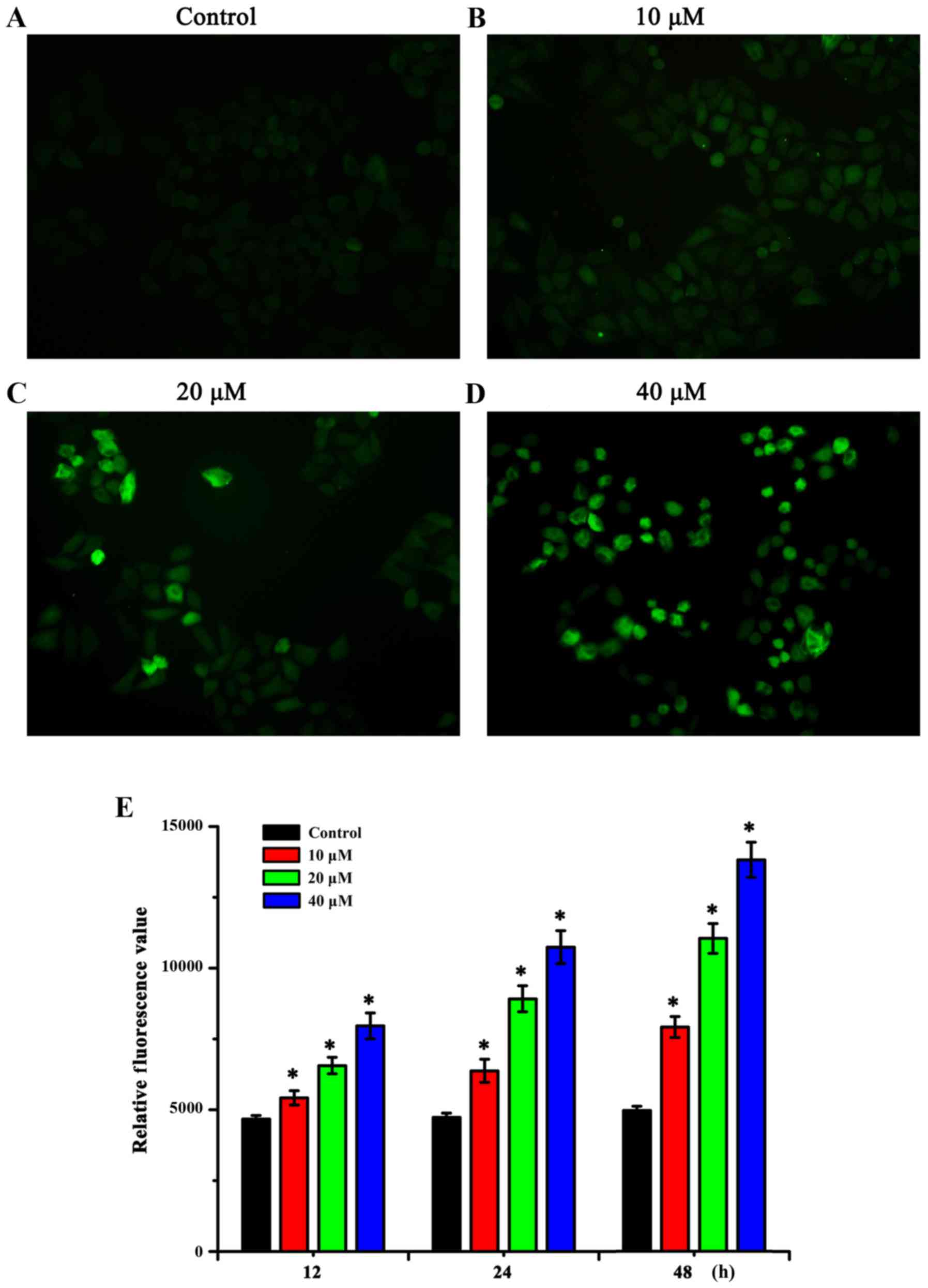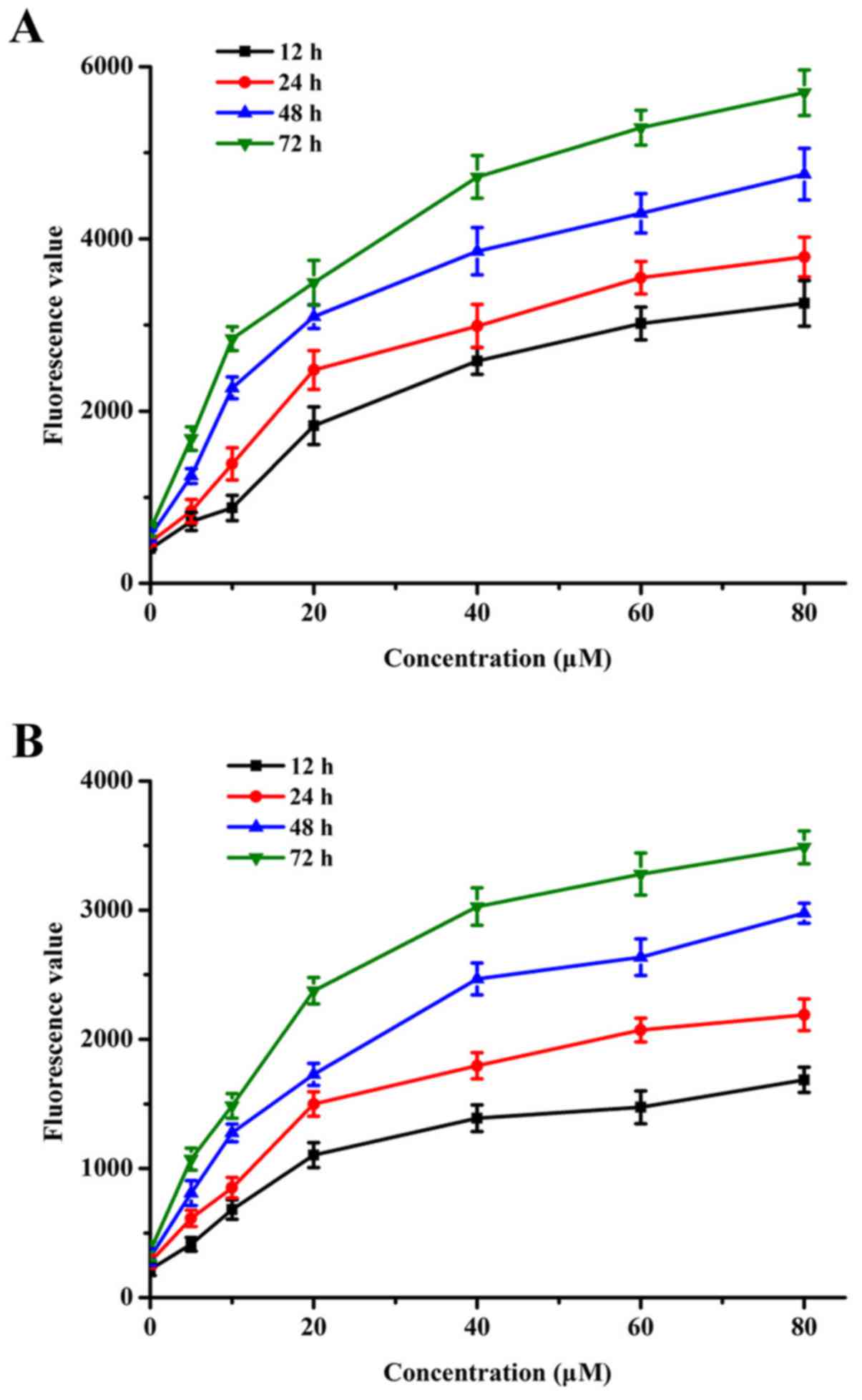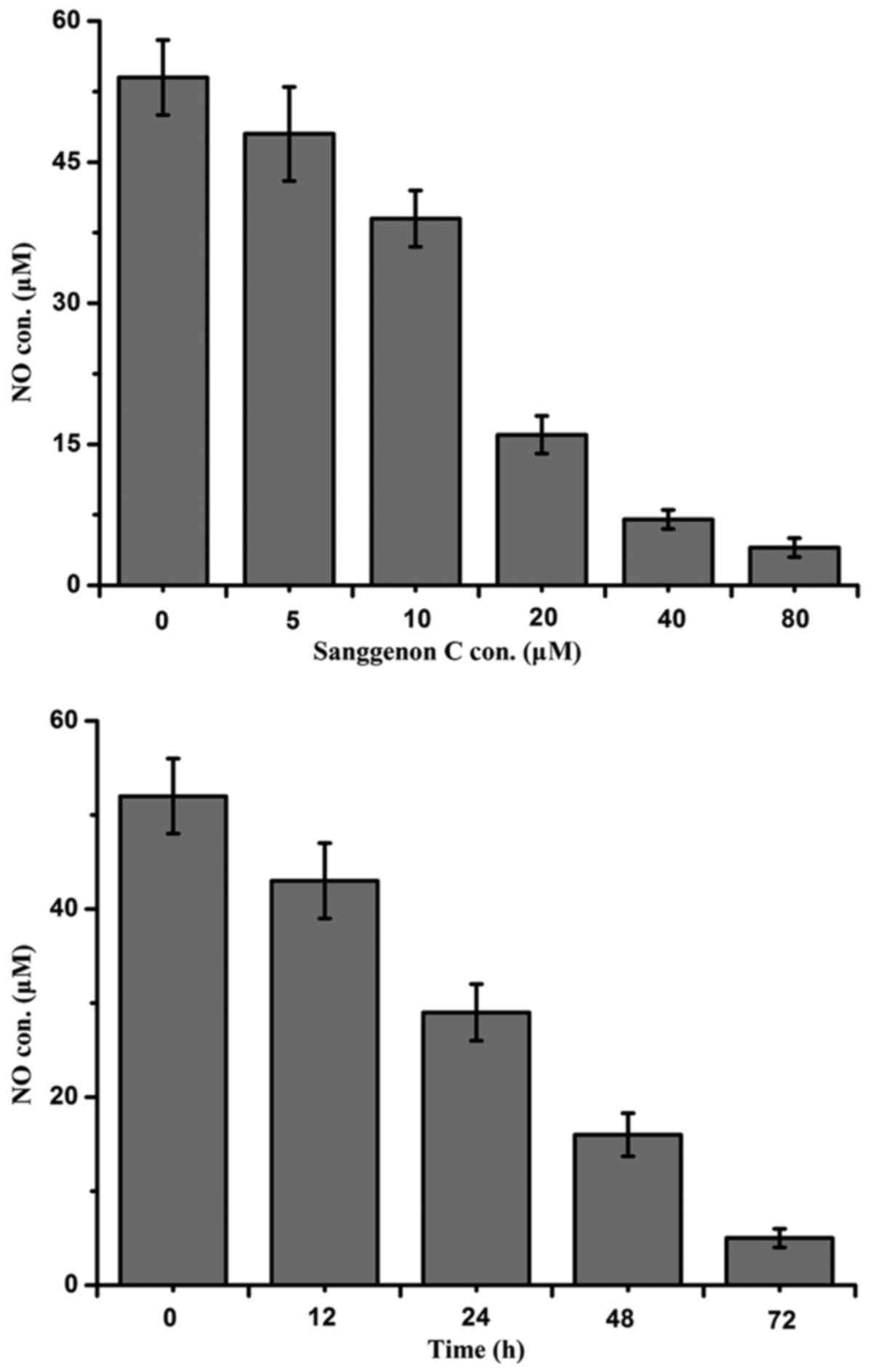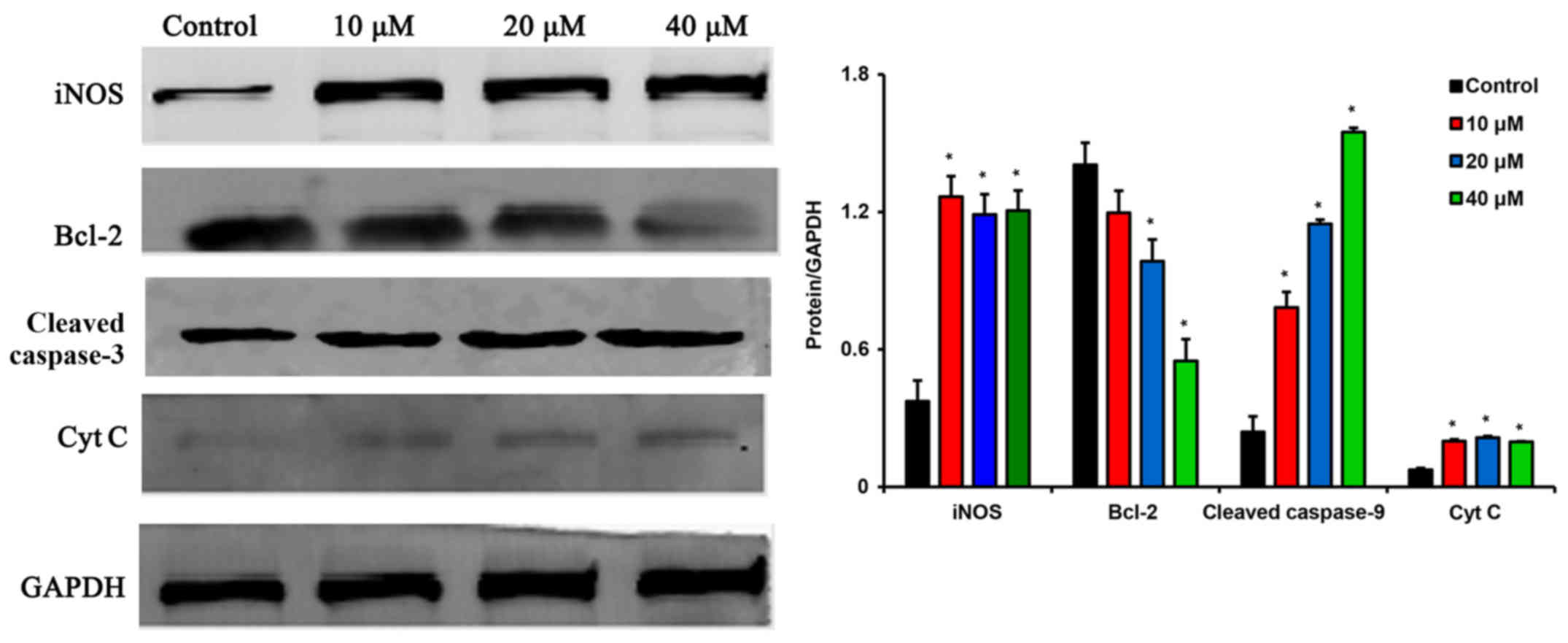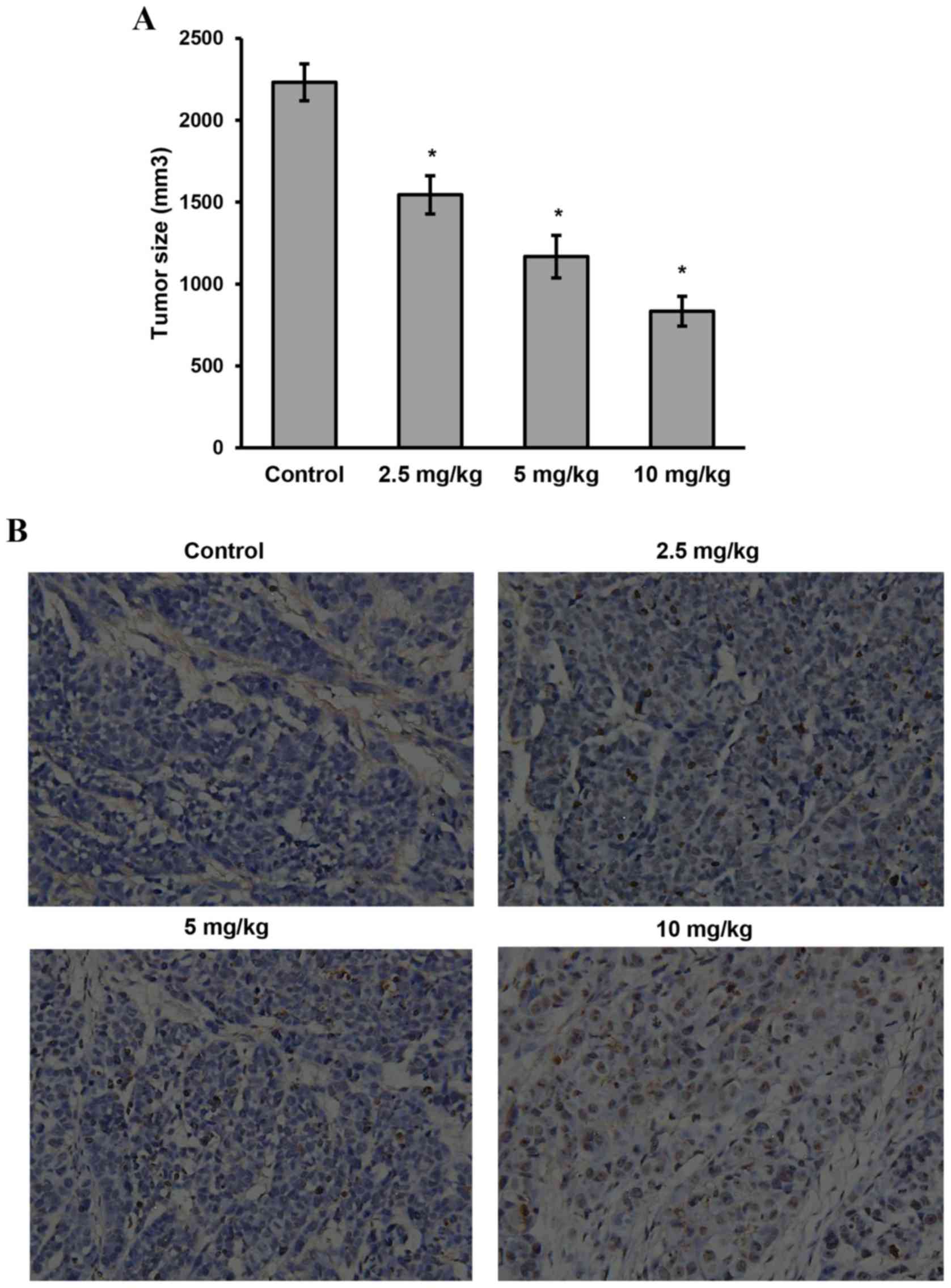Sanggenon C induces apoptosis of colon cancer cells via inhibition of NO production, iNOS expression and ROS activation of the mitochondrial pathway
- Authors:
- Published online on: August 22, 2017 https://doi.org/10.3892/or.2017.5912
- Pages: 2123-2131
-
Copyright: © Chen et al. This is an open access article distributed under the terms of Creative Commons Attribution License.
Abstract
Introduction
Colorectal cancer (CRC) is a major public health problem and the leading cause of death in the economically developed and developing countries, and is a growing burden worldwide due to increasing of the aging population (1,2). According to the statistics, CRC is the third most commonly diagnosed and deadly cancer both in males and females, with an estimated 69,090 and 63,610 new cases, and 26,100 and 23,600 deaths, respectively (1). The incidence rates of CRC are much higher in the developed countries such as Northern America, Europe, and Australia, while they are lower in economically underdeveloped areas for instance South-Central Asia and Africa (2,3). In the recent decades, the incidence rate is increasing notably in Asia, South America and Eastern Europe, which may reflect the adoption of lifestyle behaviors that increase the colorectal cancer risk, including smoking, unhealthy diet, obesity, and physical inactivity (3,4).
On the contrary, decreasing morbidity and mortality rates have been observed in a large number of developed countries worldwide which may due to a higher cancer screening rates, reduced prevalence of risk factors, as well as the improved comprehensive treatment (4–6). As far as we know, surgical resection, adjuvant chemotherapy, radiation therapy and targeted therapy are treatments that may offer curative potential for patients with CRC (7). Based on the scientific advances in affected gene detection by different technologies including gene expression tools, CRC could be classified into different molecular subtypes (7). Though improvement of comprehensive treatment has been made, CRC is clinically resistant to conventional chemotherapy treatments (8,9). Consequently, there is an urgent need to develop natural anticancer compounds which have higher efficacy and lower toxicity in the treatment of CRC.
Sanggenon C (C40H36O12), one of the most abundant flavonoids isolated from the stem bark of Morus cathayana, is a natural chemical entity of benzopyrone derivative, belonging to the class of flavonoids (10). Flavonoids are widely distributed in the plants, which possess various biological and pharmacological properties, including anticancer (11), anti-inflammatory (12), antimicrobial, antiviral (13), and immune-modulatory (14) activities. As a flavanone Diel-Alder adduct compound, sanggenon C has been reported to possess some biological and pharmacological effects, such as anti-oxidant and anti-inflammation activities, according to the few reports up to now (10,15,16). Further study demonstrated that sanggenon C could inhibit TNF-α-stimulated cell adhesion and decrease the expression of VCAM-1 through suppressing the activation of NF-κB (15). Thereafter, sanggenon C has also been proposed to decrease the ICAM-1 expression at a post-translational level. Moreover, due to the potent cell toxicity of sanggenon C, it could serve as an effective candidate anticancer agent. These reports, although invaluable, are invariably incomplete, as the precise molecular mechanisms underlying sanggenon C-induced apoptosis still remains to be delineated.
To date, there is no available information about the anticancer effects and the mechanism of sanggenon C on human colorectal cancer cells. Therefore, this study was undertaken to address the effects of sanggenon C on CRC cells in vitro and clarify its potential mechanism.
Materials and methods
Chemicals and cell culture
Sanggenon C (>98% purity) was purchased from Biorbyt Ltd. (orb105480; Biorbyt Ltd., Cambridge, UK). The sanggenon C stock solution was prepared at 1 mM in dimethyl sulfoxide (DMSO) and stored at −20°C. Human colon cancer cell lines (LoVo, HT-29 and SW480) were obtained from the Shanghai Cell Collection (Shanghai, China) and cultured in DMEM medium (Gibco, Carlsbad, CA, USA) supplemented with 10% fetal bovine serum (FBS, Gibco), 1% antibiotics (100 IU penicillin and 100 µg/ml streptomycin), then maintained in a humidified incubator at 37°C with a 5% CO2/95% air atmosphere.
Cell proliferation assay
Cell proliferation and viability was determined using the WST-8 tetrazolium salt assay (Cell Counting Kit-8; Beyotime Institute of Biotechnology, Wuhan, China) to quantify the amount of formazan dye formed when a tetrazolium salt is cleaved by cellular mitochondrial dehydrogenase. Cells were seeded in 96-well culture plates with a density of 5×103/well, and allowed to adhere for 12 h. Then the supernatant was replaced and cells were incubated in fresh medium containing sanggenon C (0, 5, 10, 20, 40 and 80 µM) diluted from the stock solution for 0, 12, 24, 48, or 72 h. At 2 h before the end of the specified incubation periods, 10 ml CCK-8 reagent was added to each well. The absorbance at 450 nm was determined using a micro-plate reader (Victor3 1420 Multilable Counter; Perkin-Elmer, Waltham, MA, USA). DMEM containing 10% CCK-8 solution was used as a control. The percentage of cell survival representing the function of drug concentration was then plotted to determine the IC50 value.
Hoechst 33258 staining
Colon cancer cells in exponential growth were modulated at a final concentration of 1×105 cells per well on sterile cover glasses in the 6-well plates. After adherence, the supernatant was replaced and cells were cultured in fresh medium containing sanggenon C (0, 10, 20, and 40 µM) for 24 h. After exposure, the cells were subsequently fixed, washed three times with PBS and stained with 0.5 ml Hoechst 33258 staining solution (Sigma-Aldrich, St. Louis, MO, USA) for 5 min at room temperature in the dark. Then washed twice with PBS and the stained nuclei with apoptotic features were scored and categorized according to the condensation and staining characteristics of chromatin under a fluorescence microscope (BX51; Olympus Co., Tokyo, Japan). Ten random fields per dish were observed and counted.
Measurement of reactive oxygen species (ROS)
The intracellular generation of ROS was measured using a 20, 70-dichlorofluorescin diacetate (DCFH-DA, Sigma-Aldrich). The adjusted concentration of colon cancer cells was 5×103 cells/well in 96-well culture plates or 1×105 cells/well in 6-well culture plates. After adherence, the supernatant was replaced and cells in 96-well culture plates were then cultured in fresh medium containing sanggenon C (0, 10, 20, and 40 µM) for 12, 24 or 48 h, while cells in 6-well culture plates were only cultured for 24 h. After exposure, the supernatant was removed, and the cells were washed with PBS for three times followed by maintaining with DCFH-DA (10 µM) in DMEM (without FBS) for 20 min and then washed again. The intracellular ROS detection of cells in 96-well culture plates was determined by the fluorescent absorbance value using a microplate reader (Victor3 1420 Multilabel Counter; Perkin-Elmer). The levels of intracellular ROS of cells in 6-well culture plates were verified by a fluorescence microscope (BX51; Olympus Co.).
Measurement of ATP
ATP assay kit (S0026, Beyotime Institute of Biotechnology) was chosen to detect the levels of ATP. Colon cancer cells (5×103 cells/well) seeded in 96-well culture plates were cultured and treated with sanggenon C (0, 5, 10, 20, 40 and 80 µM) for 0, 12, 24, 48 or 72 h as that in the measurement of intracellular ROS. After exposure, the supernatant was replaced, and cells were then broken by the lysis buffer in the kit at 4°C. Subsequently, the suspension of lysates was gathered, diluted and then mixed with the ATP detecting solution (100 µl). The levels of ATP were determined by the fluorescent absorbance value using a microplate reader with a standard curve which was calculated using the standard ATP concentration and the corresponding absorbance value as a control.
Measurement of intracellular Ca2+
The level of intracellular Ca2+ was assessed using Fluo-3/AM (S1056, Beyotime Institute of Biotechnology). Cells (5×103 cells/well) seeded in 96-well culture plates were cultured and treated with sanggenon C (0, 5, 10, 20, 40 and 80 µM) for 0, 12, 24, 48, or 72 h as that in the measurement of intracellular ROS and ATP. After exposure, the supernatant was removed, and cells were then washed three times using D-Hanks balanced salt solution (D-HBBS; Jinuo, Hangzhou, China) without Ca2+, Mg2+ and phenol red. Following, 5 µM Fluo-3/AM diluted by D-Hanks was applied to maintain cells for 60 min at 37°C. Subsequently, cells were then washed using D-Hanks further three times and balanced in D-Hanks for 30 min at 37°C. Finally, the levels of intracellular Ca2+ were determined by the fluorescent absorbance value using a microplate reader.
Measurement of nitric oxide (NO) production
Griess method was adopted to detect the production of NO using an assay kit (S0021, Beyotime Institute of Biotechnology) based on the chemical diazotization reaction, which uses sulfanilamide and N-1-napthylethylenediamine dihydrochloride (NED) under acidic (phosphoric acid) conditions. Under the above condition, two stable breakdown products, nitrate (NO3−) and nitrite (NO2−) can be easily detected by photometric means instead of NO with transient and volatile nature. Cells (5×103 cells/well) seeded in 96-well culture plates were cultured and treated with sanggenon C (0, 5, 10, 20, 40 and 80 µM) for 0, 12, 24, 48, or 72 h according to the aforementioned grouping. Then the production of NO in cells was measured by Griess method in accordance with the directions of the NO assay kit.
Western blot analysis
Colon cancer cell lysates were prepared with RIPA lysis buffer (Beyotime Institute of Biotechnology) and phenylmethylsulfonyl fluoride (PMSF, Beyotime Institute of Biotechnology). The whole extracted cellular proteins were subjected to SDS-polyacrylamide gels and electro-transferred to polyvinylidene difluoride membranes (Millipore, Billerica, MA, USA). Transfer efficiency and homogeneous loading could be assessed by Ponceau stain. Membranes were blocked with 5% non-fat milk in TBST, then immunoblotted with several titrated primary antibodies (all from Cell Signaling Technology, Beverly, MA, USA) including anti-Bcl-2, anti-cleaved caspase-9, anti-cytochrome C (Cyt C), anti-inducible nitric oxide synthase (iNOS) or anti-GAPDH, overnight at 4°C. After washing with TBST three times, the membranes were labeled with a 1:10,000 diluted secondary antibody (LI-COR Biosciences, Lincoln, NE, USA) for 1 h at room temperature before they were washed further three times. Finally, the membranes were scanned using a two-color infrared imaging system (Odyssey, Lincoln, NE, USA). Membranes were probed for GAPDH as an additional loading control, and the protein band intensity was also determined.
Xenograft tumor model
Male BALB/c-nu/nu nude mice (4–6 weeks old) were purchased from Beijing HFK Bioscience and housed in specific pathogen-free conditions under approved institutional animal care and use protocols. All animal experiments were approved by the Committee on the Use of Live Animals in Teaching and Research (CULATR), the First Affiliated Hospital of Zhengzhou University. Colon cancer cells, harvested from subconfluent cultures, washed in serum-free medium, then suspended in 100 µl PBS, were subcutaneously inoculated into the dorsal area of the nude mice. The tumor size was measured every 3 day, and when reached approximately 150 mm3 the nude mice were divided into four groups (six in each group): a control group, a low-dose group (2.5 mg/kg), a mid-dose group (5 mg/kg), and a high-dose group (10 mg/kg). Sanggenon C was administered via intraperitoneal injection every other day. Following, the mice were weighed, and the size of each tumor and its central necrotic area were monitored every 3 days. At the end of the experiment, tumors were harvested, weighed and then analyzed using hematoxylin and eosin H&E staining and TUNEL assay.
H&E staining and TUNEL assay
For histologic analysis, tumor tissue was fixed in 4% formaldehyde, dehydrated with an ethanol gradient, and embedded in paraffin. Then the paraffin tumor tissue sections (4 µm) were obtained and stained with H&E. The TUNEL assay for apoptosis analysis was performed using an apoptosis detection kit (Roche Diagnostics, Branchburg, NJ, USA) according to the manufacturer's instructions. Positive cells were identified, counted (six random fields per slides), and analyzed by light microscopy (BX51; Olympus Co.).
Statistical analysis
All data were expressed as the mean ± standard deviation (SD). The difference among groups was determined by ANOVA, while the difference between groups was analyzed by the Student's t-test using SPSS 17.0 for Microsoft Windows (SPSS Inc., Chicago, IL, USA). A P-value <0.05 was considered to indicate a statistically significant result.
Results
Sanggenon C inhibits the proliferation of colon cancer cells
The inhibition of human colon cancer cell (LoVo, HT-29 and SW480) proliferation by sanggenon C was determined by CCK-8 cell viability assay after drug exposure maintained above, following 24 h culture in a drug-free medium. As shown in Fig. 1, sanggenon C could significantly inhibit the proliferation of colon cancer cells in a dose- and time-dependent manner. Of the three colon cancer cell lines, LoVo was the most sensitive to sanggenon C, while SW480 was the least sensitive. Therefore, HT-29 was chosen for the following experiments.
Sanggenon C induces apoptosis of colon cancer cells
Apoptosis of HT-29 human colon cancer cells induced by sanggenon C was assessed by using the Hoechst 33258 staining. The apoptotic nuclei were identified by changes revealed in condensed chromatin as well as nuclear fragmentation with formation of apoptotic bodies. In the control group, the nuclei were stained lightly homogeneous blue, while in those treated with sanggenon C, bright condensed chromatin and nuclear fragmentation could be observed (Fig. 2A-D). Ten random fields per dish were counted and the mean values ± SD were expressed as the percentage of apoptotic cells. Significant changes were detected in the number of apoptotic cells, and the percentages of apoptotic cells in the control group, low-dose sanggenon C group (10 µM), mid-dose sanggenon C group (20 µM) and high-dose sanggenon C group (40 µM) were 1.27±0.46, 15.4±1.97, 26.3±3.26 and 38.9±3.13%, respectively (Fig. 2E).
Sanggenon C induces the generation of intracellular ROS
To determine whether the effect of sanggenon C on the proliferation and apoptosis of human colon cancer cells is bound to the deregulation of cellular redox status, the intracellular generation of ROS was detected using DCFH-DA. The fluorescence intensity was reflected by a fluorescence microscope which showed that sanggenon C could increase the levels of intracellular ROS in human colon cancer cells, and this accumulation was enhanced when the dose was increased (Fig. 3A-D). The fluorescent absorbance results determined by a microplate reader displayed that the relative fluorescence value changed following the changes of the dose and treatment time of sanggenon C (Fig. 3E), which indicated that sanggenon C could interfere with the levels of intracellular ROS.
Sanggenon C induces an increase in the level of intracellular Ca2+ and ATP
For the sake of understanding whether the effect of sanggenon C on the proliferation and apoptosis of human colon cancer cells is related to the fluxion of Ca2+ and the changes of generation of ATP, we assessed the levels of intracellular Ca2+ and ATP by the fluorescent absorbance value using a microplate reader. The detection results showed that sanggenon C could interfere and increase the levels of intracellular Ca2+ and ATP, both in a time-dependent manner, and this accumulation was enhanced when the dose was increased as shown in Fig. 4.
Sanggenon C inhibits the production of intracellular NO
The inhibitory effect on the production of NO induced by sanggenon C which plays a significant role on the proliferation and apoptosis of human colon cancer cells was evaluated by Griess method as described above using a microplate reader. The intracellular NO levels in the culture media were measured as nitrite concentration and the detection results showed that sanggenon C could notably interfere and inhibit the NO production both in a dose- and time-dependent manner as shown in Fig. 5.
Sanggenon C induces apoptosis of colon cancer cells via inhibiting iNOS expression and triggering the activation of the mitochondrial pathway
To further study the detailed mechanism underlying sanggenon C-induced apoptosis, we examined the effect of sanggenon C on iNOS expression and the key protein levels of mitochondrial pathway using western blotting. Sanggenon C could inhibit iNOS expression and lead to an increase in the levels of Cyt C, which is known as the critical role that activate caspase-9 and the subsequent mitochondria-mediated apoptosis. Sanggenon C caused a decrease in Bcl-2 levels as shown in Fig. 6.
Sanggenon C inhibits the growth of colon xenograft tumors in vivo
On the basis of the data above, we further investigated the effects of sanggenon C on xenograft colon tumor in vivo. As shown in Fig. 7A, tumors grew rapidly in the control group (2231.8±112.7 mm3), while the growth was significantly suppressed in the disposed groups in a dose-dependent manner (1544.7±116.8 mm3 in low-dose group, 1167.4±129.6 mm3 in mid-dose group and 833.8±91.3 mm3 in high-dose group). At the end of the experiment, the weight of the harvested tumors in control group was heavier than that of the tumors in high dose group, mid-dose group and even the low-dose group (P<0.05).
Tumor tissues isolated from the xenograft mice of the four groups were then processed for H&E staining (not shown) and TUNEL assay as described. It demonstrated that sanggenon C produced significant cell apoptosis in the tumor mass (Fig. 7B), whereas little apoptosis was observed in the control group (P<0.05).
Discussion
Redox regulation has been demonstrated to play a critical role in physiopathological contexts and the free radicals, from NO and superoxide anion (O2−) to other forms of ROS, have been proved to be involved in different biological and regulatory processes (17–19). ROS, generated from various extracellular and intracellular actions, have drawn attention as novel host defending molecular and play critical roles promoting cancer development by inducing genomic instability, modifying gene expression, as second messengers, in various signaling pathways (20,21). Mitochondrial oxidative metabolism, which release ROS as a byproduct or a waste product of normal mitochondrial metabolism and homeostasis, is the main resource of cellular ROS; while the other response to xenobiotics, cytokines or bacterial invasion which generate ROS either in molecular synthesis or in breakdown, is another resource of ROS (22,23).
Sanggenon C, a natural chemical entity of benzopyrone derivative, possesses various biological and pharmacological properties, including anticancer, anti-inflammatory, antimicrobial, antiviral, antithrombotic, and immune-modulatory activities. Previous study reported that sanggenon C induced death of human K562 cancer cells and primary cells isolated from leukemic patients via induction of cell cycle arrest and cell death (15). Our in vitro data demonstrated that sanggenon C inhibit the proliferation of colon cancer cells including LoVo, SW480, and HT-29 cells in a dose- and time-dependent manner. Sanggenon C treatment at the concentration of 10, 20, and 40 µM resulted in an induction of HT-29 cell apoptosis. We also found that sanggenon C could increase the levels of intracellular ROS in HT-29 colon cancer cells. These results were further confirmed in our in vivo study, as sanggenon C treatment suppressed xenograft colon tumor growth and enhanced xenograft colon tumor apoptosis.
Mitochondrial membrane permeabilization (MMP) is classically considered as a point of no return in multiple forms of cell death which is involved in diseases including cancer. With many different stimuli, mitochondrial Ca2+ overload was confirmed to drive ROS generation, which makes it the main triggering signal as well as ROS that leads to MMP and releases of proapoptotic factors, which initiates cell apoptosis and death (24,25). As a key signaling molecule involved in the regulation of multiple aspects of mitochondrial respiration/oxidative phosphorylation, NO is known to play a vital role in various physiological conditions, and the overproduction of NO is responsible for the pathophysiological development of cancer. The expression of NO depend on a medically relevant dual regulation pathway mediated by traditionally characterized NO synthases (NOS) including inducible (iNOS, NOS2), neuronal (nNOS, NOS1) and endothelial (eNOS, NOS3) types and by enzymatic reduction of available cellular nitrite pools by a diverse class of cytosolic and mitochondrial nitrite reductases (26,27).
The role of the calcium-independent iNOS in tumorigenesis is highly complex and quite perplexing, with both pro- and anti-neoplastic functions having been described. The dual actions of iNOS-derived NO show that the mount of NO, cell types, cellular microenvironment, its interaction with other reactive species and presence of metals are contributing factors to these observations and ultimately to cellular outcomes (28,29). Sanggenon C was studied for the mechanism of its action in the ROS generation and apoptotic pathway in the HT-29 colon cancer cells. Treatment of Sanggenon C resulted in increased levels of intracellular Ca2+ and ATP. In addition, there was a decrease in the cellular levels of NO production in the sanggenon C treated HT-29 colon cancer cells. Furthermore, our study demonstrated that the cytotoxic effect of sanggenon C on the HT-29 appeared to be through inhibition of iNOS expression, which is known to activate the activity of caspase-9 and the subsequent mitochondria-mediated apoptosis. Thus, sanggenon C may represent a novel chemotherapeutic agent worth continued investigation in the treatment of CRC.
In this study, we evaluated sanggenon C-induced apoptosis in HT-29 colon cancer cells as a result of the increased ROS generation and activation of the mitochondrial pathway by the inhibition of the iNOS and decreased NO production. These results lead us to speculate that sanggenon C may play a role in an apoptotic cascade in HT-29 colon cancer cells via mitochondrial pathway. This study is potentially interesting with regard to the antitumor effect of sanggenon C as it relates to the development of novel chemotherapeutic approaches in the treatment of malignant CRC.
References
|
Siegel RLMK, Miller KD and Jemal A: Cancer statistics, 2015. CA Cancer J Clin. 65:5–29. 2015. View Article : Google Scholar : PubMed/NCBI | |
|
Torre LA, Bray F, Siegel RL, Ferlay J, Lortet-Tieulent J and Jemal A: Global cancer statistics, 2012. CA Cancer J Clin. 65:87–108. 2015. View Article : Google Scholar : PubMed/NCBI | |
|
Center MM, Jemal A and Ward E: International trends in colorectal cancer incidence rates. Cancer Epidemiol Biomarkers Prev. 18:1688–1694. 2009. View Article : Google Scholar : PubMed/NCBI | |
|
Edwards BK, Ward E, Kohler BA, Eheman C, Zauber AG, Anderson RN, Jemal A, Schymura MJ, Lansdorp-Vogelaar I, Seeff LC, et al: Annual report to the nation on the status of cancer, 1975–2006, featuring colorectal cancer trends and impact of interventions (risk factors, screening, and treatment) to reduce future rates. Cancer. 116:544–573. 2010. View Article : Google Scholar : PubMed/NCBI | |
|
Bosetti C, Levi F, Rosato V, Bertuccio P, Lucchini F, Negri E and La Vecchia C: Recent trends in colorectal cancer mortality in Europe. Int J Cancer. 129:180–191. 2011. View Article : Google Scholar : PubMed/NCBI | |
|
Favoriti P, Carbone G, Greco M, Pirozzi F, Pirozzi RE and Corcione F: Worldwide burden of colorectal cancer: A review. Updates Surg. 68:7–11. 2016. View Article : Google Scholar : PubMed/NCBI | |
|
Aran V, Victorino AP, Thuler LC and Ferreira CG: Colorectal cancer: Epidemiology, disease mechanisms and interventions to reduce onset and mortality. Clin Colorectal Cancer. 15:195–203. 2016. View Article : Google Scholar : PubMed/NCBI | |
|
Guo J, Xu S, Huang X, Li L, Zhang C, Pan Q, Ren Z, Zhou R, Ren Y, Zi J, et al: Drug resistance in colorectal cancer cell lines is partially associated with aneuploidy status in light of profiling gene expression. J Proteome Res. 15:4047–4059. 2016. View Article : Google Scholar : PubMed/NCBI | |
|
Shi Y, Huang XX, Chen GB, Wang Y, Zhi Q, Liu YS, Wu XL, Wang LF, Yang B, Xiao CX, et al: Dragon (RGMb) induces oxaliplatin resistance in colon cancer cells. Oncotarget. 7:48027–48037. 2016. View Article : Google Scholar : PubMed/NCBI | |
|
Dat NTBP, Binh PT, Quynh TP, Huong HT and Minh CV: Sanggenon C and O inhibit NO production, iNOS expression and NF-κB activation in LPS-induced RAW264.7 cells. Immunopharmacol Immunotoxicol. 34:84–88. 2012. View Article : Google Scholar : PubMed/NCBI | |
|
Sobral F, Calhelha RC, Barros L, Dueñas M, Tomás A, Santos-Buelga C, Vilas-Boas M and Ferreira I: Flavonoid composition and antitumor activity of bee bread collected in northeast Portugal. Molecules. 22:pii: E248. 2017. View Article : Google Scholar : PubMed/NCBI | |
|
Ren J, Zheng Y, Lin Z, Han X and Liao W: Macroporous resin purification and characterization of flavonoids from Platycladus orientalis (L.) Franco and their effects on macrophage inflammatory response. Food Funct. 8:86–95. 2017. View Article : Google Scholar : PubMed/NCBI | |
|
Jeong JJ and Kim DH: 5,7-Dihydroxy-6-methoxy-flavonoids eliminate HIV-1 D3-transfected cytoprotective macrophages by inhibiting the PI3K/Akt signaling pathway. Phytother Res. Jun 22–2015.(Epub ahead of print). View Article : Google Scholar | |
|
Liu XY, Xu L, Wang Y, Li JX, Zhang Y, Zhang C, Wang SS and Zhang XM: Protective effects of total flavonoids of Astragalus against adjuvant-induced arthritis in rats by regulating OPG/RANKL/NF-κB pathway. Int Immunopharmacol. 44:105–114. 2017. View Article : Google Scholar : PubMed/NCBI | |
|
Huang H, Liu N, Zhao K, Zhu C, Lu X, Li S, Lian W, Zhou P, Dong X, Zhao C, et al: Sanggenon C decreases tumor cell viability associated with proteasome inhibition. Front Biosci (Elite Ed). 3:1315–1325. 2011.PubMed/NCBI | |
|
Li LCSF, Shen F, Hou Q and Cheng GF: Inhibitory effect and mechanism of action of sanggenon C on human polymorphonuclear leukocyte adhesion to human synovial cells. Acta Pharmacol Sin. 23:138–142. 2002.PubMed/NCBI | |
|
Redza-Dutordoir M and Averill-Bates DA: Activation of apoptosis signalling pathways by reactive oxygen species. Biochim Biophys Acta. 1863:2977–2992. 2016. View Article : Google Scholar : PubMed/NCBI | |
|
Nickel A, Kohlhaas M and Maack C: Mitochondrial reactive oxygen species production and elimination. J Mol Cell Cardiol. 73:26–33. 2014. View Article : Google Scholar : PubMed/NCBI | |
|
Kaludercic N, Deshwal S and Di Lisa F: Reactive oxygen species and redox compartmentalization. Front Physiol. 5:2852014. View Article : Google Scholar : PubMed/NCBI | |
|
Zorov DB, Juhaszova M and Sollott SJ: Mitochondrial reactive oxygen species (ROS) and ROS-induced ROS release. Physiol Rev. 94:909–950. 2014. View Article : Google Scholar : PubMed/NCBI | |
|
Chong SJLI, Low IC and Pervaiz S: Mitochondrial ROS and involvement of Bcl-2 as a mitochondrial ROS regulator. Mitochondrion. 19:39–48. 2014. View Article : Google Scholar : PubMed/NCBI | |
|
Pereira EJ, Smolko CM and Janes KA: Computational models of reactive oxygen species as metabolic byproducts and signal-transduction modulators. Front Pharmacol. 7:4572016. View Article : Google Scholar : PubMed/NCBI | |
|
Murphy MP: Understanding and preventing mitochondrial oxidative damage. Biochem Soc Trans. 44:1219–1226. 2016. View Article : Google Scholar : PubMed/NCBI | |
|
Carraro M and Bernardi P: Calcium and reactive oxygen species in regulation of the mitochondrial permeability transition and of programmed cell death in yeast. Cell Calcium. 60:102–107. 2016. View Article : Google Scholar : PubMed/NCBI | |
|
Görlach A, Bertram K, Hudecova S and Krizanova O: Calcium and ROS: A mutual interplay. Redox Biol. 6:260–271. 2015. View Article : Google Scholar : PubMed/NCBI | |
|
Zhou L, Zhang H and Wu J: Effects of nitric oxide on the biological behavior of HepG2 human hepatocellular carcinoma cells. Exp Ther Med. 11:1875–1880. 2016. View Article : Google Scholar : PubMed/NCBI | |
|
Astuti RI, Watanabe D and Takagi H: Nitric oxide signaling and its role in oxidative stress response in Schizosaccharomyces pombe. Nitric Oxide. 52:29–40. 2016. View Article : Google Scholar : PubMed/NCBI | |
|
Wang J, He P, Gaida M, Yang S, Schetter AJ, Gaedcke J, Ghadimi BM, Ried T, Yfantis H, Lee D, et al: Inducible nitric oxide synthase enhances disease aggressiveness in pancreatic cancer. Oncotarget. 7:52993–53004. 2016. View Article : Google Scholar : PubMed/NCBI | |
|
Vannini F, Kashfi K and Nath N: The dual role of iNOS in cancer. Redox Biol. 6:334–343. 2015. View Article : Google Scholar : PubMed/NCBI |



